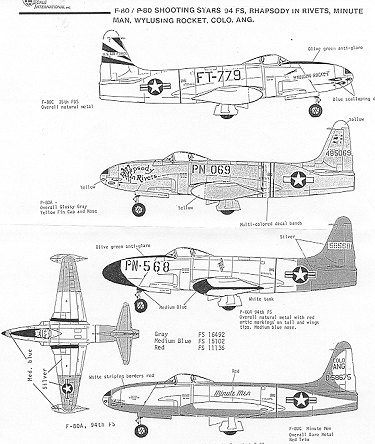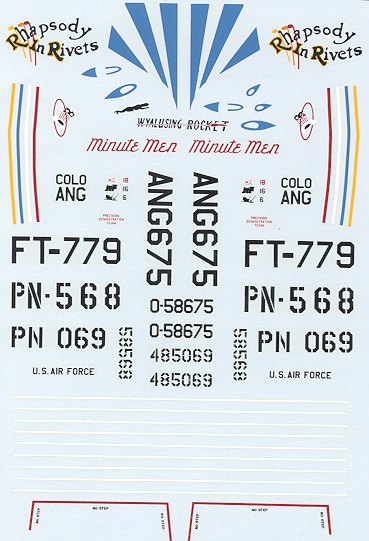|
Sheet # |
Microscale 48-035 for F-80 Shooting Star |
|
Price: |
$6.00 |
|
Unit: |
35 FBS, ?, 94 FIS, 120 FS |
|
Review By: |
Scott Van Aken |
|
Notes: |
|
 Though
the Monogram F-80C kit is still the only Shooting Star in 1/48, it still makes
into a very nice model, though you do have to take care in building. Typical of
the era in which it was designed, it has raised detail for all the panel lines
except for control surfaces and intake/exhaust ports. There is a lot of
discussion about whether a kit is better or not because of the way that the
panel lines are depicted on a kit. In reality, you will not find a mass of
recessed lines when you look at a real aircraft. These panels are butt-joined
and on some aircraft, they overlap each other.
Though
the Monogram F-80C kit is still the only Shooting Star in 1/48, it still makes
into a very nice model, though you do have to take care in building. Typical of
the era in which it was designed, it has raised detail for all the panel lines
except for control surfaces and intake/exhaust ports. There is a lot of
discussion about whether a kit is better or not because of the way that the
panel lines are depicted on a kit. In reality, you will not find a mass of
recessed lines when you look at a real aircraft. These panels are butt-joined
and on some aircraft, they overlap each other.
These butt-joined panels may
have sealant between them, in which case the demarcation line would be raised
somewhat. In reality, the joins are smoothed out and covered with several coats
of primer and paint. That means that neither method is exactly correct.
If you look at a real aircraft from the standard viewing distance of a model
(about 1 foot), in 1/48, that would be about 48 feet. From that distance, minute
detail is not that visible. Why do I bring this up? Too many people equate
raised panel lines with bad model. That really isn't the truth. If you are
building nothing but newer kits with engraved lines, you are cheating yourself
from building a number of very fine kits.
Back to the decal sheet for a
moment. All of the standard markings (insignia, USAF lettering, stencil data)
will have to come from somewhere else as they are not included. This is very
typical of very early Microscale sheets like this one. The idea was to give you
maximum choices.
 The first aircraft is an F-80C from the 35th
FBS in Korea circa 1952. All of the trim is in blue for this one.
The first aircraft is an F-80C from the 35th
FBS in Korea circa 1952. All of the trim is in blue for this one.
The next three are all
P/F-80As There are some subtle differences between the early aircraft and the
Monogram kit. I'd recommend a good reference before starting any of these
schemes. Often early planes were retrofitted with things from newer builds so a
reference is paramount. Never trust decal instruction drawings as they are just
for a general reference.
The next plane is a P-80A.
These were all in an overall grey called Pearl Grey. It is close to ADC grey,
but lighter in color. This unit put all its WWII kill markings on the tails.
Next is a 94 FS P-80A with
Arctic red markings on the tail and wings. Combine that with the blue trim
(which you have to paint) and you have a very colorful plane.
Finally, a display team plane
from the Colorado ANG. All the red will have to be painted. The stripes
are included, but good luck getting them to fit those curves. I have never seen
this scheme built in the 30 years I have been doing models.
If you are looking for
something a bit different for your F-80, try this sheet.
Review copy courtesy of me
and my wallet.
If you would like your product reviewed
fairly and quickly by a site that has over 1700 visits a day, please contact me or see other details in the Note to Contributors.
 Though
the Monogram F-80C kit is still the only Shooting Star in 1/48, it still makes
into a very nice model, though you do have to take care in building. Typical of
the era in which it was designed, it has raised detail for all the panel lines
except for control surfaces and intake/exhaust ports. There is a lot of
discussion about whether a kit is better or not because of the way that the
panel lines are depicted on a kit. In reality, you will not find a mass of
recessed lines when you look at a real aircraft. These panels are butt-joined
and on some aircraft, they overlap each other.
Though
the Monogram F-80C kit is still the only Shooting Star in 1/48, it still makes
into a very nice model, though you do have to take care in building. Typical of
the era in which it was designed, it has raised detail for all the panel lines
except for control surfaces and intake/exhaust ports. There is a lot of
discussion about whether a kit is better or not because of the way that the
panel lines are depicted on a kit. In reality, you will not find a mass of
recessed lines when you look at a real aircraft. These panels are butt-joined
and on some aircraft, they overlap each other. The first aircraft is an F-80C from the 35th
FBS in Korea circa 1952. All of the trim is in blue for this one.
The first aircraft is an F-80C from the 35th
FBS in Korea circa 1952. All of the trim is in blue for this one.